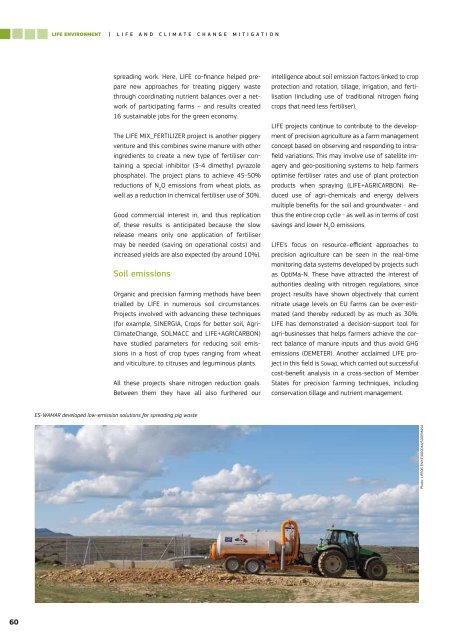You also want an ePaper? Increase the reach of your titles
YUMPU automatically turns print PDFs into web optimized ePapers that Google loves.
LIFE ENVIRONMENT |LIFE and Climate CHANGE mitigationspreading work. Here, LIFE co-finance helped preparenew approaches for treating piggery wastethrough coordinating nutrient balances over a networkof participating farms – and results created16 sustainable jobs for the green economy.The LIFE MIX_FERTILIZER project is another piggeryventure and this combines swine manure with otheringredients to create a new type of fertiliser containinga special inhibitor (3-4 dimethyl pyrazolephosphate). The project plans to achieve 45-50%reductions of N 2O emissions from wheat plots, aswell as a reduction in chemical fertiliser use of 30%.Good commercial interest in, and thus replicationof, these results is anticipated because the slowrelease means only one application of fertilisermay be needed (saving on operational costs) andincreased yields are also expected (by around 10%).Soil emissionsOrganic and precision farming methods have beentrialled by LIFE in numerous soil circumstances.Projects involved with advancing these techniques(for example, SINERGIA, Crops for better soil, Agri-ClimateChange, SOLMACC and LIFE+AGRICARBON)have studied parameters for reducing soil emissionsin a host of crop types ranging from wheatand viticulture, to citruses and leguminous plants.All these projects share nitrogen reduction goals.Between them they have all also furthered ourintelligence about soil emission factors linked to cropprotection and rotation, tillage, irrigation, and fertilisation(including use of traditional nitrogen fixingcrops that need less fertiliser).LIFE projects continue to contribute to the developmentof precision agriculture as a farm managementconcept based on observing and responding to intrafieldvariations. This may involve use of satellite imageryand geo-positioning systems to help farmersoptimise fertiliser rates and use of plant protectionproducts when spraying (LIFE+AGRICARBON). Reduceduse of agri-chemicals and energy deliversmultiple benefits for the soil and groundwater - andthus the entire crop cycle - as well as in terms of costsavings and lower N 2O emissions.LIFE’s focus on resource–efficient approaches toprecision agriculture can be seen in the real-timemonitoring data systems developed by projects suchas OptiMa-N. These have attracted the interest ofauthorities dealing with nitrogen regulations, sinceproject results have shown objectively that currentnitrate usage levels on EU farms can be over-estimated(and thereby reduced) by as much as 30%.LIFE has demonstrated a decision-support tool foragri-businesses that helps farmers achieve the correctbalance of manure inputs and thus avoid GHGemissions (DEMETER). Another acclaimed LIFE projectin this field is Sowap, which carried out successfulcost-benefit analysis in a cross-section of MemberStates for precision farming techniques, includingconservation tillage and nutrient management.ES-WAMAR developed low-emission solutions for spreading pig wastePhoto: LIFE06 ENV/E/000044/SODEMASA60


